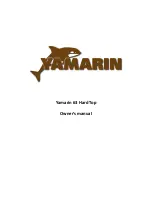
10-3
Table Of Contents
www.SkeeterBoats.com
CARE / MAINTENANCE
Direct Battery Charging
See ELECTRICAL SYSTEM on page 7-1 for charging trolling motor batteries information.
Secure the battery compartment doors in the OPEN position. Observing polarity, connect the battery
charger to the battery posts.
Onboard Charger
Charging through the optional onboard charger can be performed by securing the battery
compartment doors in the OPEN position. Plug a properly grounded extension cord into a 110-volt AC
outlet. Place the receptacle end into the permanently mounted charger inlet on the boat. Charging will
begin automatically.
CORROSION PROTECTION
Galvanic Corrosion
Galvanic corrosion (electrolysis) is the breakup of metals due to the effects of electrolytic action.
When dissimilar metals are immersed in a conductive fluid such as salt water, an electric current
is produced, similar to the action of a battery. The softest of the metals will be the first to become
damaged. If not stopped, a great deal of damage could occur.
If you operate in salt, polluted, or brackish waters, your boat should be equipped with a transom-
mounted zinc anode to prevent damage to those metal parts coming in contact with the water. By
design, the anode is selfsacrificing. It is slowly eroded by electrolytic action and requires periodic
inspection for deterioration. If the zinc anode shows extreme erosion, it must be replaced for
continued protection.
Consult your Skeeter Dealer for additional information concerning galvanic corrosion.
Salt Water Corrosion
The entire boat, outboard, and trailer should be rinsed with fresh water and washed immediately after
use in salt water. If the boat is used primarily in salt water, wax the hull monthly and apply corrosion
inhibitor to all hardware. See your Skeeter Dealer for products suitable for the marine salt water
environment.
See your outboard operator’s manual for cooling system flushing information.
CAUTION
DO NOT paint or coat a zinc anode with any substance. Once covered, the anode will not
provide protection from galvanic corrosion. Replace the anode if it is deteriorated 50%
or more.
















































